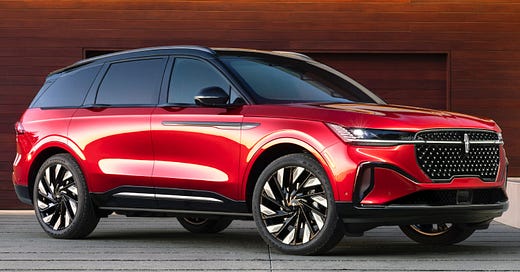Why Buying a Car Made in America Matters
No matter what car you buy, you help to keep Americans employed. But buying a car made in America carries far more weight.
Let me share a personal story with you. An old classmate from my Michigan high school recently reached out to me on Facebook, clearly irritated that Lincoln will build the redesigned 2024 Nautilus SUV in China and ship it to the U.S. market. After his rant, he asked: “Do any other car companies do this?”

I told him yes. The Buick Envision also comes from China, and Chinese-made Teslas are now flowing into Canada (though not the U.S. market). I explained the backstory of the Buick and Lincoln brands in China, why the Envision and Nautilus are made there and sent here, and the growing influence of Chinese consumers on the global automotive market (For example, their preferences are one reason BMWs have giant grilles now.)
My former classmate thanked me for the explanation but clearly was not happy about it.
Now, how many people who purchase the Buick Envision or drive home in the all-new 2024 Lincoln Nautilus will believe they’re doing their part to “buy American”? Many, I am sure. And if they discover their vehicles were assembled in China, they could get pretty mad.
For example, when GM declared bankruptcy and received a government bailout in 2008, my neighbors across the street immediately sold their Cadillac and got a new Honda Accord. She told me they would never buy a GM product again. And they haven’t. The entire family drives Hondas, Nissans, and Toyotas now.
Why we must redefine what it means to “buy American”
In 2015, the Center for Automotive Research (CAR) published “Contribution of the Automotive Industry to All Fifty States and the United States.” I’m going to directly quote the executive summary here:
“Over 7 million private sector jobs supported by auto manufacturers, suppliers and dealers in the United States”
“$500 billion paid in annual compensation to employees supported by the automotive industry”
“Every vehicle manufacturer job creates almost 7 other jobs in industries across the economy”
“All direct auto industry employment creates almost 4 additional jobs in other industries across the economy”
When you buy a vehicle that is made in the U.S.A., you contribute to an American economic engine that CAR says accounts for 3.8% of all private sector employment in the U.S.
Granted, these figures include dealerships, including those that sell vehicles made elsewhere in the world and which contain little to no U.S.-sourced parts content. So even if you buy, say, a Mazda CX-5, built in Japan with no parts from America, you’re helping a Mazda dealer to remain open, employing people both at the dealership and in the local area.

But, if you opted instead for a Mazda CX-50 built in Huntsville, Alabama, or a Honda CR-V built in Ohio or Indiana, you’d be helping your fellow Americans in a much more meaningful way. Just make sure the first digit in the CR-V’s vehicle identification number (VIN) is a 1, 4, or 5. If it’s a 2, it was made in Canada.
Buying a vehicle made in America hasn’t always been important to me or to my wife. But when we needed to replace our 15-year-old 2005 Nissan Murano, we wanted a vehicle that rolled off an American assembly line. Our Acura MDX Sport Hybrid was built in East Liberty, Ohio, and nearly two-thirds of its parts (60%) were sourced in the U.S. or Canada*.
Before you angrily grumble to yourself about how the profits from the sale of that Acura flowed to Japan, remember that Ford and General Motors (GM) used their tax-break windfalls from the Tax Cuts and Jobs Act of 2017 to buy back shares of their own stock in order to reward company shareholders.
Then, within a year, GM laid off approximately 10 percent of its workforce and closed or idled numerous North American factories.
After that, in 2019, GM allowed the longest United Auto Workers (UAW) strike since 1970 to cripple the company, hobbling the rollout of the redesigned full-size pickup trucks that fuel the automaker’s profits.
In addition, you need to remember that Stellantis NV, the entity resulting from the merger of Fiat Chrysler Automobiles and France’s Groupe PSA, is headquartered in Amsterdam, not Detroit. That means when you buy a Chrysler, Dodge, Jeep, or Ram, your money ultimately flows to the Netherlands, not Michigan.
Now, what was that about the flow of profits?
My purchase of an Acura helped keep Ohioan factory workers employed, helped keep workers at the suppliers that provided the majority of the parts employed, helped keep small business owners in geographic proximity to the factory and parts suppliers employed, and helped keep American Honda personnel all around the country employed. No doubt, the salesperson at my local Acura dealership made some money, too.
That’s why buying a vehicle made in America matters. And that’s also why oversimplifying your decision based on the vehicle’s badge or the company that ultimately receives the profit does not.
You need to consider where a car, truck, or SUV is manufactured, not where you think a brand or car company is based.
*The American Automobile Labeling Act automatically groups the U.S. and Canada together when reporting parts content percentages.
Did you enjoy this article? Do you know anyone who might like to subscribe to Driving American? Please share this publication with them to help support the mission to ensure prosperity for hard-working Americans. Thanks!



